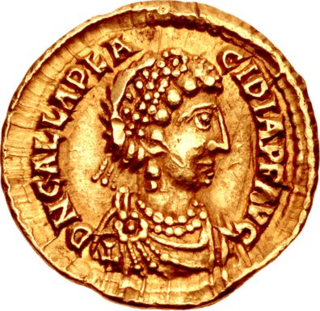
Honorius was Roman emperor from 393 to 423. He was the younger son of emperor Theodosius I and his first wife Aelia Flaccilla. After the death of Theodosius, Honorius ruled the western half of the empire while his brother Arcadius ruled the eastern half. In 410, during Honorius's reign over the Western Roman Empire, Rome was sacked for the first time in almost 800 years.

Galla Placidia, daughter of the Roman emperor Theodosius I, was a mother, tutor, and advisor to emperor Valentinian III, and a major force in Roman politics for most of her life. She was queen consort to Ataulf, king of the Visigoths from 414 until his death in 415, briefly empress consort to Constantius III in 421, and managed the government administration as a regent during the early reign of Valentinian III, until her death.
The 400s decade ran from January 1, 400, to December 31, 409.
The 380s decade ran from January 1, 380, to December 31, 389.
The 430s decade ran from January 1, 430, to December 31, 439.
The 420s decade ran from January 1, 420, to December 31, 429.

Year 408 (CDVIII) was a leap year starting on Wednesday of the Julian calendar. At the time, it was known as the Year of the Consulship of Bassus and Philippus. The denomination 408 for this year has been used since the early medieval period, when the Anno Domini calendar era became the prevalent method in Europe for naming years.

Year 407 (CDVII) was a common year starting on Tuesday of the Julian calendar. At the time, it was known as the Year of the Consulship of Honorius and Theodosius
(or, less frequently, year 1160 Ab urbe condita). The denomination 407 for this year has been used since the early medieval period, when the Anno Domini calendar era became the prevalent method in Europe for naming years.
The 390s decade ran from January 1, 390 to December 31, 399
The 410s decade ran from January 1, 410, to December 31, 419.
The 440s decade ran from January 1, 440, to December 31, 449.

Year 411 (CDXI) was a common year starting on Sunday of the Julian calendar. At the time, it was known as the Year of the Consulship of Theodosius without colleague. The denomination 411 for this year has been used since the early medieval period, when the Anno Domini calendar era became the prevalent method in Europe for naming years.

Year 366 (CCCLXVI) was a common year starting on Sunday of the Julian calendar. At the time, it was known as the Year of the Consulship of Gratianus and Dagalaifus. The denomination 366 for this year has been used since the early medieval period, when the Anno Domini calendar era became the prevalent method in Europe for naming years.
The 360s decade ran from January 1, 360, to December 31, 369.
The 370s decade ran from January 1, 370, to December 31, 379.

Year 384 (CCCLXXXIV) was a leap year starting on Monday of the Julian calendar. At the time, it was known as the Year of the Consulship of Ricomer and Clearchus. The denomination 384 for this year has been used since the early medieval period, when the Anno Domini calendar era became the prevalent method in Europe for giving names to years.
Year 380 (CCCLXXX) was a leap year starting on Wednesday of the Julian calendar. At the time, it was known as the Year of the Consulship of Augustus and Augustus. The denomination 380 for this year has been used since the early medieval period, when the Anno Domini calendar era became the prevalent method in Europe for naming years.

Athaulf was king of the Visigoths from 411 to 415. During his reign, he transformed the Visigothic state from a tribal kingdom to a major political power of Late Antiquity.

Constans II was caesar or heir apparent to his father Emperor Constantine III from 407 to 409 and co-emperor with Constantine and the Western Roman Emperor Honorius from 409 until his death. Constans was a monk prior to his father being acclaimed emperor by the army in Britain in early 407. Constans was summoned to the new imperial court, in Gaul, appointed to the position of Caesar and swiftly married so that a dynasty could be founded. In Hispania, Honorius's relatives rose in 408 and expelled Constantine's administration. An army under the generals Constans and Gerontius was sent to deal with this and Constantine's authority was re-established. Honorius acknowledged Constantine as co-emperor in early 409 and Constantine immediately raised Constans to the position of co-emperor, theoretically equal in rank to Honorius as well as to Constantine. Later in 409 Gerontius rebelled, proclaimed his client Maximus emperor and incited barbarian groups in Gaul to rise up. Constans was sent to quash the revolt, but was defeated and withdrew to Arles. In 410, Constans was sent to Hispania again. Gerontius had strengthened his army with barbarians and defeated Constans; the latter withdrew north and was defeated again and killed at Vienne early in 411. Gerontius then besieged Constantine in Arles.

The Valentinianic or Valentinian dynasty was a ruling house of five generations of dynasts, including five Roman emperors during Late Antiquity, lasting nearly a hundred years from the mid fourth to the mid fifth century. They succeeded the Constantinian dynasty and reigned over the Roman Empire from 364 to 392 and from 425 to 455, with an interregnum (392–423), during which the Theodosian dynasty ruled and eventually succeeded them. The Theodosians, who intermarried into the Valentinian house, ruled concurrently in the east after 379.










